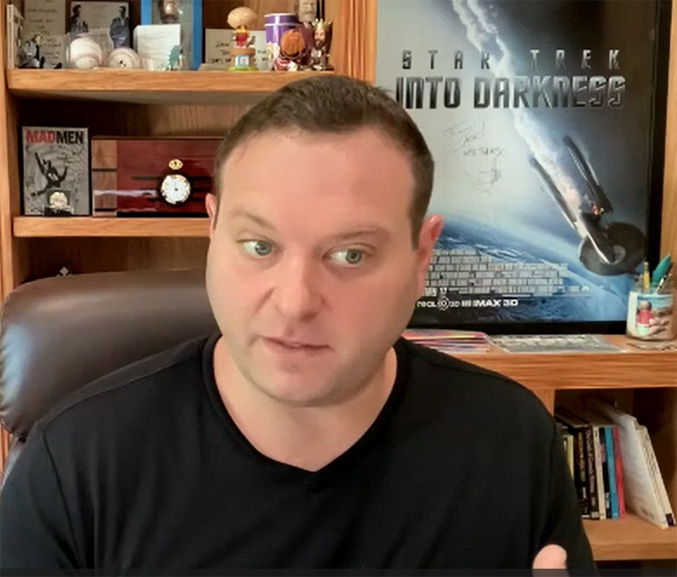Thought Leadership Studio Podcast Episodes:
Interview with Zack Gutin of Think Alike Media
Episode 44 - On Why Great Minds Think Alike and Scripting the Stories of Marketing

#contentmarketing, #emailmarketing, #filmmaking, #insight, #interviews, #marketing, #marketingresearch, #marketingstrategy, #marketlistening, #persuasion, #sales, #storytelling, #strategicthoughtleadership, #thoughtleadershipmarketing
Or Click here to listen or subscribe on appWhat this episode will do for you
- Discover how Zack's journey from screenplay writing shaped his expertise in creating compelling stories for marketing.
- Learn the art of story-driven marketing and how it can revolutionize your approach to reaching customers.
- Understand the importance of identifying and addressing customer problems as a way to capture their attention and build a connection.
- Gain insights into the significance of being approachable and worth talking to.
- Uncover the essential components of a good story in the context of outbound selling.
Zack Gutin.
Join us as we dive into the world of storytelling and its powerful impact on marketing with our guest Zack Gutin, the president and founder of Think Alike Media.
Zack Gutin is a seasoned marketing strategist and sales expert with a remarkable track record in the media and entertainment industry.
Formerly the Vice President of Sales at Final Draft Inc, he played a pivotal role in driving significant revenue growth and spearheading successful product launches.
As the founder of ThinkAlike Media, Zack has consulted with various organizations, revitalizing sales systems and achieving impressive revenue increases.
His expertise has been sought after by renowned industry brands, and he has a passion for helping companies thrive. Zack resides in Los Angeles, CA, with his family.
Some of Zack's coordinates:
Curated Transcript of Interview with Zack Gutin
The following partial transcript is lightly edited for clarity - the full interview is on audio. Click here to listen.
Chris McNeil: I'm Chris McNeil, host of Thought Leadership Studio, and I'm sitting here with Zack Gutin, the president and founder of Think Alike Media. Welcome, Zach.
 Zack Gutin: Thanks so much, Chris. Appreciate it. Fun to be here.
Zack Gutin: Thanks so much, Chris. Appreciate it. Fun to be here.
Storytelling - from Movies to Marketing
Chris McNeil: Same. And my understanding is that you are a master of storytelling. Tell us a little bit about how you became a master of storytelling and how that has played into creating stories (in marketing) and helping clients create stories.
Zack Gutin: Yeah. You know, our company is, is called Think Alike Media. And, the service that we provide to clients, we refer to it as story-driven marketing. You know, it'd be hard to call myself a master storyteller to the degree that some of the most creative people in the world are. But I think that my background in story ... I started my career in journalism and then into screenwriting and got to work in, in television and film. ...And then also work with a company - a technology that served the creative community: screenwriters and filmmakers.
And then, I started to see the connective tissue between the two. The way that you tell stories in journalism and through screenwriting. All stories, whatever medium they're in, are driven by problems and started to find that so are buying decisions.
Businesses make buying decisions. People make decisions to solve problems. And if you can introduce those problems to people, they're ready to listen to solutions. If you lead with a solution, they may not understand that they have the problem in the first place and they might not listen.
So, you know, storytelling is really kind of helping people to relate to a problem, whether that's through a main character in a book or a movie or a problem that a prospect in a sales campaign might have. If they recognize a problem, you're gonna kind of catch their attention and that gives you a chance to kind of show them solutions and tell a story.
Chris McNeil: So is is kind of leading them on a journey rather than just saying, "Here's what we've got". It's more like, "Let's take, let's take you on a journey to discover why you would possibly need what we have".
Zack Gutin: Absolutely. You know, we say, and we have one of our great examples: We have a client who's an executive kitchen based in the Bay area of San, of California. And they serve a lot of big technology firms around Silicon Valley in terms of employee meal plans. And they have these amazing menus that are built through collaborations with with celebrity chefs. And I always say like, I think most marketers would look at what they have and think, lead with the menu, lead with these very cool menus. But if on the receiving end you're not thinking about feeding your employees in the first place, what good is that menu?
 So instead we always lead with kind of the taking care of their employees. whether that's a firm in biotech where their staff never got to go work remote, they've been in office the whole time, all their friends and family got to work from home for the last two years and shed those commutes.
So instead we always lead with kind of the taking care of their employees. whether that's a firm in biotech where their staff never got to go work remote, they've been in office the whole time, all their friends and family got to work from home for the last two years and shed those commutes.
We can say that and kind of strike a nerve for the HR folks at those biotech firms to say, your employees deserve to be fed. Well, because they've stayed in the office during this period of time, everyone else in their lives is working remotely now. They want to see the menu because now they understand that they need to do something for their employees. They understand the problem. If they didn't understand that problem, they wouldn't care about the menus.
And so the same is sort of true. We then, you know, different targets, different problems. When we moved into instead of biotech into let's say big tech firms that largely for the last couple years were working remotely, but at the turn of this year in Q1 started to bring them back. So different story to those people. Your staff has been working from home for two years. They've been in their pajama pants and, and, and making food at home, having whatever they want, you're gonna bring them back on those commutes, build morale through some good food.
And so we always wanna start with the problem, start with the story. And that's what sort of drives people to what's attractive about an offer from a business. We really got to hit them where it hurts first.
Chris McNeil: Well, and a good story evokes emotions, doesn't it?
Zack Gutin: Absolutely. Yeah. You strike a nerve.
Chris McNeil: Yeah. And yet how many people just try to persuade or sell logically ...
Zack Gutin: Yeah. And that's why I always say with that particular case too. It makes total sense. Most people would come to it and, and just think, this is an amazing menu. The auspices behind this organization is so cool. There's a celebrity component to it. So why not lead with that? Well unfortunately, if they don't see that problem, they don't strike that nerve, then they don't really necessarily care about that part.
The Different Perspective of Outbound Marketing
And I think that's true in just about every product or service. There is a problem that has to be surfaced. And especially in the work that we do, which is very sort of cold outreach driven sort of starting relationships. You know, un unlike an inbound lead who has already acknowledged that problem and is searching for a solution when you go outbound, you need to make sure that they have surfaced that problem in the first place. And that's the thing that we help help clients do, I think really is good as anybody.
Chris McNeil: Interesting. So you, would you say you specialize more in outbound marketing or more in inbound?
Zack Gutin: Correct. Yeah, outbound, definitely.
Chris McNeil: So you have to really develop a relationship and, and get some rapport before you start leading someone into that solution stage.
Zack Gutin: Absolutely. Rapport's so important. We, you know, we, we talk endlessly about being story driven. In order to be story driven, you have to be hyper-targeted. You have to know who you're talking to, to sort of understand the environments and the problem they're in. Biotech versus big tech in the office during the pandemic, out of the office during the pandemic. Two different stories, two different groups of people. But the other thing besides story driven and hyper targeting is you, all of those things would fail if you're not conversational. You have to be approachable. You have to be worth talking back to.
 I tell people all the time, a lot of people businesses make mistakes in doing outbound marketing where in a sense they're really just kind of throwing it out into the world. They're just kind of sending out white papers, they're sending out bulleted lists of things that they do great and they just think, throw it against the wall and see what sticks.
I tell people all the time, a lot of people businesses make mistakes in doing outbound marketing where in a sense they're really just kind of throwing it out into the world. They're just kind of sending out white papers, they're sending out bulleted lists of things that they do great and they just think, throw it against the wall and see what sticks.
But if you really think about the people that you're talking to and try to get them to talk back to you, try to get them engaging with you, that's where you're going to find a lot more momentum in a sales process or in any effort to start a forge a relationship to get them talking to you, learn more about them, give them a chance to learn more about you. And as human beings, inherently we start to get to know one another and feel a connection. and if there's a chance to work together from that point, it's going to blossom.
But, you know, so much of bad sales and marketing is this kind of overaggressive try to force somebody's hand into a contract. It just doesn't work that way. You know, we, we're all still human beings at the, at the end of the day and we want to be approached with this element of respect.
And, the comparison I always give it to it is we're doing in a digital format what a lot of people do at things like trade shows. And just imagine if you walked up to somebody at a trade show, you would choose to go to that show because you would expect your prospects might be there. You can see from their name badge a little bit about who they are, who they work for, the role that they play. And you might say, that's somebody I should talk to.
Now imagine you walked up and started spouting out features and benefits and ROI numbers they would call security because they would be so strange to have someone come walking up to you and just start shooting information at you. Instead, you'd walk up and you'd introduce yourself. You'd shake your hand, you'd give them your name, you'd start to talk to one another, be a human. And we want to do that in our campaigns too. And I think it's so important to start the process of melting the ice as to be a human.
Chris McNeil: Absolutely. And that example I could see only really working if you're selling a security service and use that as a counter example and "Look at how security responded to this. I wasn't really trying to sell you that but I think you look for these points in a security service and now that's apparent."
Zack Gutin: (laugh) Now you want personnel around you because of people like me!
Chris McNeil: Yeah, exactly. We actually can provide that service (laugh).
 But yeah, it's interesting, you know, and I've always found the movie analogy, the screenplay writing as being one of the roles I see in Strategic Thought Leadership where you're scripting out the vision of where you're taking people's thinking.
But yeah, it's interesting, you know, and I've always found the movie analogy, the screenplay writing as being one of the roles I see in Strategic Thought Leadership where you're scripting out the vision of where you're taking people's thinking.
Zack Gutin: That's right.
Chris McNeil: And then you got the director role where you're bringing it to life with media and engagement and interactions. And then, the audience role where you're seeing it from the audience's point of view. And it seems like you're really attuned to that because you realize you can't just jump in with a sales message, but you have to kind of see it from their point of view: Listen to what they have to say, get a feeling for where their, their crunch spots are, where their bottlenecks are and getting what they want and leading them along that way.
So what are the essential components that make a good story that you've been able to bring over from screenplay writing into this context of outbound selling?
Zack Gutin: Yeah. You know, it's a few different things. You know, hyper targeting is a really important part of it - it's understanding your audience. You know, if you were writing a children's comedy, you would be aware of sort of the degree of sophistication of the jokes that you wouldn't be dialing it up to a level of political humor because the kid's not gonna understand that.
And so you, you would, you would have to be thinking about your audience and what you can say to them and what can, what is going to compel them. it has to be familiar for them to use that same example, a problem that serves a main character in a children's comedy has got to be something that a kid can understand and kind of get on board for and go on the ride for. You can't they're not going to understand certain things that maybe a parent would understand instead.
And so from a sales and marketing perspective it is the same thing. Who is this audience? What is the things that we should be saying to them to in, in a sense, ingratiate ourselves and get them talking to them? You know, we again always want to be sort of warm and friendly and, and conversational. We don't want to be too aggressive. And, and so thinking about who are those folks?
And even to the degree as, as you mentioned of sort of scripting it out of like, what's the cadence of follow up to these people given their work environment, what's gonna be too aggressive too fast in terms of follow up? What is a more polite cadence? and from a systemization standpoint, you know, one of the great things that we're able to leverage in outbound marketing is things like behavioral triggers.
We can see when somebody has clicked a link and come to a website, at which point we wanna say something a little different script, something a little different to that person because they've now been educated a little bit more. They've been on a site, on a landing page, seen other forms of media that the business might have put together. And so we really want to, you know, shift the story to that person. and it's very powerful in that way. if you think of, you know, film and television and, and concepts of things like choose your own adventure and you know, a younger generation right now using tools like, like mind games like Minecraft and a generation before with, with Sims is the, the ability to sort of construct and put together things based on their own pacing things that interest them.
And that's what we want. We want our prospects to have their own journey. Each prospect should have their own interaction with messages that should trigger something unique to that. and and ultimately, you know, I think for the prospects standpoint, they appreciate that. They appreciate that they weren't just bombarded with messages as fast as possible, that it came to them when they had a chance to look at it. So, you know, they didn't look at it for two, three weeks.
Suddenly now they're on the website, they're gonna see more messages, it's convenient timing for them. So really sort of planning the, around the audience and what, who they are, what their environment's like, and the things that are going to be important to them.
Chris McNeil: Right. Well, I'm seeing some things and hearing some things in here. They're very interesting and a couple pieces: It seems like you're not just scripting a story for them, but you're also entering into their story.
 Zack Gutin: Yeah, that's right. It is their story.
Zack Gutin: Yeah, that's right. It is their story.
Connecting Stories, Entering Their Worlds
Chris McNeil: So you're kind of gluing your story that you want to lead them into to the story they're already participating in. So you're entering their world.
Zack Gutin: That's right. It's that they are living this story. And this is where, you know, the interesting thing between outbound and inbound marketing is a lot of times they've got the same problem. Inbound leads versus outbound. The outbound leads that we had to, we have to go and get either they aren't thinking as actively about it as the inbound leads who are trying to go find solutions. you know, or, or they're blissfully unaware that one way or the other, they are living with that problem and, and it is their story.
And I tell our clients all the time, we can close deals without the recipe and formula being perfect. But when the recipe and formula is perfect mm-hmm. (affirmative), what happens is you're almost doing the homework for the prospect. They will respond and say things like, "You know, I've been looking for a solution for this. My boss last week told me I needed to go find something, like to help us with this problem. And you landed here."
And when that happens, and it does happen for us, we tell them to the point of it's their story. Don't tell your boss that we reached out to you. You take all the credit. You were working on this for four hours until you found us and we, and then you came and found and, and and reached out to us. You be the hero. They're the hero. It's their problem. They're solving it. They're the hero of the story.
So as much as we are driving a story based on conflict, they may not realize it yet. They're the main character. They're, it's their story. They're the hero of it. And that's how great stories should unfold themselves is we found the problem, we figured out a solution, and now it's solved. and that's the journey
Chris McNeil: That seems really relevant to a lot of our listeners, that I understand are people like consultants, they're coaches, they're HR directors, CMOs, marketers, and people who have a need to and maybe do more outbound marketing.
Zack Gutin: Yep.
Chris McNeil: And get better at it. And I was in a field for a long time - in there fitness business where I had one, one-on-one training studios, that was almost pure outbound. We had a really good selling process, but it required reaching out to people and triggering in that we used some advertising, but we used a lot of lead generation with referrals where we called on people.
And then I went into something almost pure inbound with my marketing agency where it's been purely referral based mainly. But now things are shifting and I'm getting into other fields and really enjoying the coaching and consulting piece and realizing you've got to do some outbound in that.
But I'm hearing you talk about some of the same tools that I associate more with that - and this is education for me. So it's very intriguing to see these tools that I've associated with inbound marketing, like white papers... or creating white papers and do some SEO and post them on social media and wait for people to come to them. And you're, you're talking about using them as an outbound tool. How's, what's that distinction in using things like white papers for outbound versus inbound?
Zack Gutin: Yeah. Well, when we're using resources content, whether it's white papers, landing pages case studies or anything like that we refer to that as social proof. we like to lead first with, you know, from a systemization standpoint, we want one URL in each message. Just a great kind of trick to outbound is you don't put multiple links. People make a very easy mistake of "here's my website and here's my Calendly link". Well, that second link just moved you into more spam folders than you would want.
And so a simple trick is making sure there's only that one link. So we always start with one link, and that might be a landing page something about the business, something about the the product. and then once they're clicking on that, we like to leverage afterwards social proof.
So the follow up that goes to somebody who's already come to that page. That's where we like to use things like white papers data that might be available. Where now it's like, "okay, we've got them looking. Let's just layer on more information for them." So you can almost see them interacting with a preliminary set of information. And that's usually your kind of, you know doorway into like, "okay, let's give them more now". And you can understand when they're ready to consume more, because you can see that they're clicking links and therefore you trigger those follow-ups.
Again, somebody who hasn't yet clicked the first link don't layer on more information, they haven't had a chance to start really looking at it. So you know, any bit of social proof, any bit of data that exists can be leveraged as a talking point. You don't want to necessarily lead with it and say like, "here's the white paper, go read the white paper" because we want them to talk back to us. So you want that conversational tone. You don't wanna give them a homework assignment, you want to give them the start of a conversation.
And we find that's where they tend to engage most is in that follow up of wanting to absorb more information.
System Vs. Customized Path
Chris McNeil: How much does this fall into a coherent system that you can apply with the variety of different types of clients versus how much do you feel like you need to customize the path of the story and the media using different touchpoints depending on the type of clients you're working with?
Zack Gutin: Well, we there's definitely certain forms of media that would be detrimental to the type of work that we do. We can't embed videos and photos and things like that because when you're doing cold outreach, spam filters are looking at you and evaluating you. Strike One is if we've never interacted with your email address before, and in cold outreach, that's always gonna be a hurdle. So then from that point, the scrutinization becomes, you know, are you carrying attachments and all of those things get you moved to spam.
So it's really important that you're not layering in media and cold outreach really make it text-based. I know a lot of businesses' default to, "we need them to see this". If they need to see it, then your marketing is not strong enough yet. Because if them visualizing it is the only thing that's going to make it powerful for them, that's gonna fall apart, that's very weak.
You need to be able to strike a nerve with them emotionally that makes them want to dive into visuals and charts and other things like that. So none of that exists. None of that media exists in our outreach and that's tailored intentionally for all of our clients. Some of our clients have very visual products. We work with a company that does digital art displays. There's no visuals in those emails that are going out. You would think it would need to be a rotating set of banners of art. It's not. o
We have a client - this catering company does this. The food that they present is amazing. When you look at it on their website, it's incredible presentation. But if we led with those images, we'd wind up in spam folders. So it's really important to set ourselves up for a foundation of success and leave attached media out, really make it about great writing.
Chris McNeil: Well, it seems like you're almost like a Sherpa guide for the adventurers to get them around the digital gates keepers.
Zack Gutin: Yes, for sure.
Chris McNeil: Part of everybody's world in selling now is "How do you get in?"
Zack Gutin: And it's getting harder...
***************************************
The transcript is lightly edited for clarity and is a partial transcript- the full interview is on audio. Click here to listen.
***************************************
Free Stuff and Offers Mentioned in Podcast
***************************************
***************************************